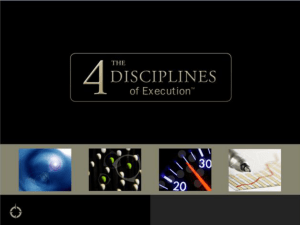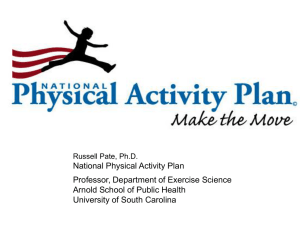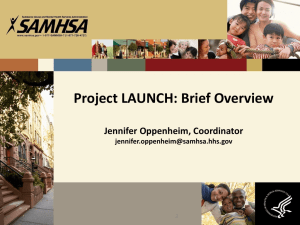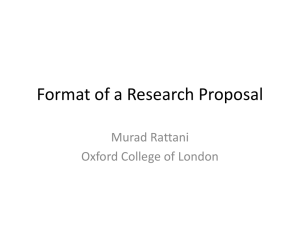AGI 1_2006
advertisement
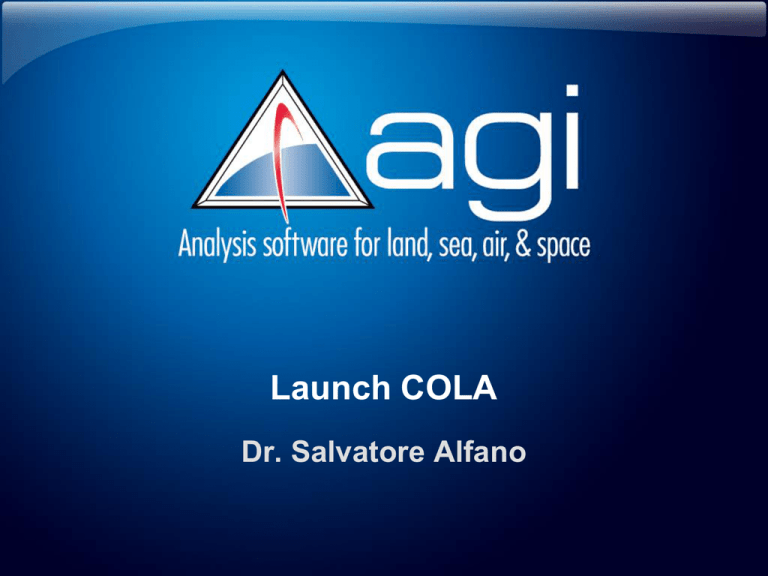
Launch COLA Dr. Salvatore Alfano Outline Problem Statement – Space Object Environment Standard formulation – Description – Issues JSPOC use case AGI’s patented solution method – Re-formulate the problem Questions and answers 2 Problem statement Find permissible launch times Given – Launch trajectory Designed in the Earth Fixed frame Motion characterized in MET (Mission Elapsed Time) – MET = seconds past Launch time – Satellite Catalog Given in the Earth Centered Inertial (ECI) frame Motion characterized in civil time – Launch window Time interval in civil time (absolute time scale) Example: 12 Feb 09 05:00:00 to 12 Feb 09 11:00:00 UTC Launch may occur anytime during this window 3 Problem Statement (Cont’d) Concern: close approaches with space objects – Launching missile won’t be able to perform avoidance maneuver – Satellite object may not be able to move (debris) – Satellite object unaware of launch – Satellite object unwilling to move Which time intervals in the launch window are NOT safe for launch? – These are the Launch Blackout intervals 4 Space object environment 12,000+ objects (publicly) cataloged by USSTRATCOM – Mostly debris with significant ephemeris uncertainty (3-20km) Object ephemeris modeling – SGP4 using a TLE Analytic routine (fast) Accurate for short durations (days) Each object’s TLE is routinely updated every few days – SP (Special Perturbations propagator) Numerically integrated trajectories 5 Definitions Primary Secondaries Close Approach Designed launch trajectory Other space objects range < given threshold Compute All time intervals during the launch window for which the primary will have a close approach with some secondary if launched during that interval 6 Standard formulation Identify the set of secondaries to consider – Use ephemeris generated near launch window time – Filter out secondaries based upon apogee of launch trajectory Choose a sampling of times within the launch window – Every 60 sec, 10 sec, 1 sec, etc. For each sampled time – Transform launch trajectory to inertial frame sampled time = launch time – Perform close approach to secondaries – If close approaches are detected, then sampled time is in Blackout interval 7 Standard formulation (cont’d) Do analysis in civil time – Convert MET incrementally for each launch time Do analysis in ECI frame – Transform MET incrementally for each launch time Will probably want to gather some further results – Close approach objects, minimum approach distance Assimilate all results 8 Issues Sampling rate – Events occur over short durations (seconds) Argues for using small time steps – Launch Window is long (hours) – May need to do many cases to assess entire window Large number of cases – More cases means more computational time – More cases means more results to process when determining the Blackout windows 9 Issues (cont’d) Accuracy requires timely data – Ephemerides may not be valid for long times – Argues for doing the analysis close to the time of launch window itself Can all the cases be computed and assessed at a time close to the launch window but before it starts? 10 Still need to investigate Planning – How to plan months in advance of the launch window? Launch trajectory design – How can one assess the impact of trajectory changes knowing the computations may take a long time? Resetting the Launch Window – Slips occur for lots of reasons – How fast can a new assessment be made for the new window? 11 JSPOC Use Case AGI In-House Hardware Configuration – Intel® Xeon® CPU – 8 cores @ 2.13 GHz – 24 GB RAM – All tests results obtained using only 1 core Launch Window Example Configuration – 6 hour launch window – Primary trajectory MET duration ~ 15 min – Conjunction range threshold – 40 km Example Catalog – ~12,000 secondaries using ephemeris files generated from publicly available TLEs – Method not limited to TLEs 12 Results Launch Window Sampling Strategy Fixed at Fixed at Fixed at Fixed at AGI 60 sec 10 sec 1 sec 0.5 sec Launch COLA Conjunctions Detected < 1% 5.4 % 50 % >99 % 100 % Compute Time 40 min 4 hrs 46.7 hrs 108.8 hrs 3.1 min Found 573 conjunctions Shortest blackout interval ~ 0.2 sec Smallest minimum range ~ 22 m 13 AGI Launch COLA papers “Determination of Close Approaches for Earth Fixed Launch Trajectories” – Jim Woodburn, AAS 98-134, 1998. – http://www.stk.com/downloads/resources/userresources/downloads/whitepapers/CloseAppToEFL aunch.pdf US Patent 6,102,334 Issued 15 Aug 2000 – “METHOD AND APPARTATUS FOR DETERMINING CLOSE APPROACHES FOR EARTH-FIXED LAUNCH TRAJECTORIES” by Jim Woodburn of AGI 14 AGI-Patented solution strategy Transform the analysis space – Use Earth-fixed frame rather than Inertial frame – Use MET in addition to civil time Each MET time value – Locates a single Earth-fixed position of launch trajectory – Corresponds to the considered interval (in civil time) Start: Launch window start + MET Stop: Launch window stop + MET – The considered interval determines an arc of each secondary’s trajectory 15 AGI-Patented solution strategy Take advantage of conjunction metrics that are well behaved in MET in Earth-fixed frame – No need to sample at small steps to detect short conjunctions – Use small number of samples for determining functional trends – Accurately identify extrema and threshold crossing events by iteratively sub-sampling as needed Convert MET events into launch times (civil times) 16 Minimum possible range Secondary Trajectory Secondary position at given civil time Minimum Possible Range Range Sample Launch vehicle position at a given MET 17 Solution strategy (cont’d) Is secondary’s arc within range threshold at this position in the launch trajectory? – No: no close approach at this MET – Yes: secondary does have close approach If Yes: – Determine time interval within the considered interval for which range < threshold (i.e., conjunction time interval) – Convert this conjunction time interval into a time interval in the launch window when primary must have launched for the close approach to have occurred 18 Conjunction time interval Sample each secondary’s arc Use event detection routine to look for threshold crossing – Identifies a conjunction time interval within considered interval Range Sample Range Threshold time-into-considered-interval Conjunction time interval 19 Computation Strategy Filter out secondaries based upon perigee For each secondary not filtered out – Judiciously sample launch trajectory in MET – Compute conjunction intervals at each sample, where range < threshold This itself requires judicious sampling and iterative subsampling – Iteratively sub-sample in MET to precisely determine the envelope of all conjunction intervals for this secondary – Convert envelope boundary time interval into timeinto-launch-window interval (thus, blackout interval) 20 Conjunction Timing Just Touches 21 MET conjunctions Shape of mapping is important Latest end time Blackout start time Blackout end time Earliest start time Conjunction Timing Touches twice 1 2 23 MET conjunctions Shape of mapping is important Latest end time 2 1 Blackout start time Blackout end time Earliest start time 24 Conjunction Timing Touches twice 1 2 25 MET conjunctions Shape of mapping is important Latest end time 2 1 Blackout start time Blackout end time Earliest start time 26 MET conjunctions Shape of mapping is important = 1.6 s DTwindow Blackout Latest end time Blackout start time Blackout end time Earliest start time MET = 1.2 s 27 Concerns addressed AGI Launch COLA: – Can make plans in advance and continually update the results – Can easily account for changes to launch trajectory design – Can easily account for resetting the launch window – Can be run very close to launch window start, using the best available data as of that time for best prediction accuracy 28 JSPOC Use Case Extended – Part 1 Extension from a single launch to multiple simultaneous launches from nearby sites Which time intervals in the launch window are NOT safe for launch from any of the given launch sites? – These are the Launch Blackout intervals for the entire set of multiple simultaneous launches 29 Problem Statement Given – Launch trajectories and launch window as before – Launch sites are close and trajectories remain in close proximity Simultaneous launches from all launch sites may occur anytime during the launch window AGI Solution - treat trajectories as a cluster – Generate single reference trajectory for the entire cluster – Create new conservative range threshold for the entire cluster – Compute conservative blackout intervals for reference trajectory using conservative range threshold – Refine blackout intervals for individual trajectories 30 Reference for multiple launches Define single reference launch site and trajectory, e.g. average of all launch trajectories in Earth-fixed frame in MET Reference trajectory Launch sites Reference launch site 31 Max dispersion distance Determine maximum distance of any launch vehicle from the reference position at any time in MET Positions at some MET Positions at MET=0 Maximum dispersion distance at MET 32 Filter using reference trajectory Compute conservative blackout intervals using reference launch trajectory with range threshold set to max dispersion distance + original range threshold + additional “pad” Conservative range threshold sphere Additional “pad” Original range threshold sphere 33 Individual trajectory processing Filtered conservative blackout intervals are refined using launch window analysis of actual individual trajectories – Computational savings result from using filtered blackout intervals which are typically much shorter than the overall launch window 34 JSPOC Use Case Extended – Part 2 Extension from a finite set of launch sites to launches from anywhere within a continuous area Which time intervals in the launch window are NOT safe for launch from anywhere within given area? – These are the Launch Blackout intervals for the entire area 35 Problem Statement Given – Launch trajectory and launch window as before – Method for changing Earth-fixed MET trajectory from one launch site to another within specified area Launch may occur anytime during the launch window and anywhere within the specified area 36 Area Launch Definition Rectangular area in lat-lon space Earth-fixed MET trajectory is defined for some launch site within the area (e.g. its center) Trajectory is modified when moved to a different launch site within the area, e.g. – Same trajectory in local topocentric frame – Same Earth-fixed MET burnout point – Other methods are possible 37 Area Launch – Same Trajectory Trajectories are fixed in MET in local topocentric frame for each launch site A lot of samples to cover the area 38 Area Launch – Same Burnout Point Burnout point fixed in MET in Earth-fixed frame is the same for any launch site A lot of samples to cover the area 39 Standard formulation Sample launch area at some acceptable resolution For each sample launch site – Perform launch window analysis – Accumulate results Report accumulated results from all sampled sites 40 Issues How to determine acceptable area resolution? Fine resolution over large area = many launch sites = many analyses to run – 100 km x 100 km at 10 km resolution = 100 launches It may be difficult to obtain answers that are both timely and accurate 41 Primary Trajectory Surface at MET At a given MET, positions of all possible primary trajectories starting within specified launch area make up primary trajectory surface Primary Trajectory Surface at a given MET Launch Area (MET = 0) 42 Minimum possible range to surface Sample on secondary trajectory Corresponding Min Range point on Primary trajectory surface Secondary Trajectory Primary trajectory surface at a given MET Minimum Possible Range for entire surface at a given MET 43 AGI Solution Start using approach similar to clustered trajectories case – Generate reference trajectory for the area – Create conservative padded range threshold – Compute conservative blackout intervals Refine blackout intervals – Replace range computation to a single position at MET with range computation to the nearest point on the surface at MET – Nearest point is found using judicious sampling and iterative sub-sampling of surface points – Clearing any and all points on the surface means clearing the nearest point 44 Judicious Area Sampling Judicious sampling works well for areas of various size Initial samples 45 Results Extended Launch AGI Launch Window COLA Sampling Strategy Compute Time 3.1 min AGI Launch COLA for 18 trajectories AGI Clustered Launch COLA for 18 trajectories AGI Area Launch COLA Rectangular Area 100 x 100 km 23.9 min 3.2 min 3.7 min Fixed computational cost is associated with loading secondary ephemeris files for processing – independent from the number of primary trajectories 46 Metrics 12,000 ephemeris files generated from TLEs – 35 minutes on a 1-core PC for all objects for 5 days – 90 points per orbit Apply perigee filter to all 12,000 – 11,000 satellites eliminated (1,000 left) Run launch COLA for 100km x 100km case – – – – – 6 hour launch window Primary trajectory MET duration ~ 15 min Conjunction range threshold – 40 km 4 minutes processing time Conjunctions found ~ 600 47 Video of multiple launches COLA_Red.wmv 48 Results Combined 49 50 Questions & answers



